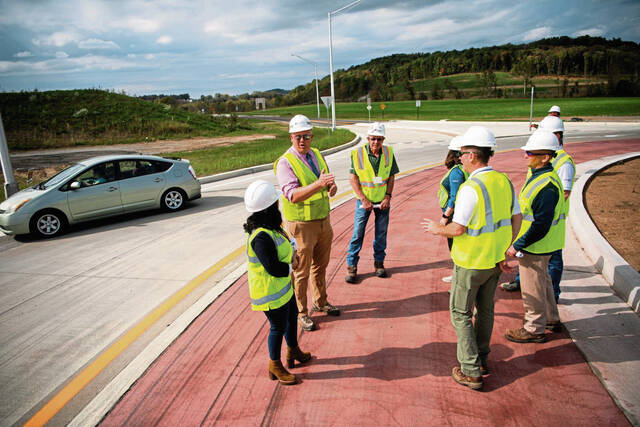New roundabouts at I-70 exits spotlighted during tour
PennDOT’s ongoing Interstate 70 improvement projects were center stage this week during a tour that highlighted the importance of transportation funding.
The tour took a group of state legislators, contractors and engineering consultants to several roundabouts in Sewickley Township and New Stanton while also stopping at a concrete plant to educate attendees about the concrete paving industry. The goal was to highlight the industry while also pointing out why transportation funding sources are necessary.
“A lot of us don’t get the chance to actually go out and kick the pavement and take a look at the pavement and see how it performs and why we’re doing what we’re doing,” said John Becker, president of the American Concrete Pavement Association Pennsylvania chapter.
The tour began at the northern roundabout of the Madison interchange, located off Exit 54 of I-70. The roundabout, near the Westinghouse plant, is located on Waltz Mill Road and will provide access to Commerce Crossing at Westmoreland, a 200-acre industrial park being developed by the Westmoreland County Industrial Development Corp.
This week, it was announced that construction on the first parcel will start this year.
The roundabout, already open to traffic, is part of a more than $101.4 million project that will bring three traffic circles to the area to replace stop-controlled intersections — one each for eastbound and westbound traffic, where on- and off-ramps meet, and the third tying together Waltz Mill, Waltz Mill Flats Road and a relocated section of Borough Line Road.
Standing in a circle on the side of the roundabout, attendees dressed in bright green safety vests and white hardhats learned about the life cycle of concrete pavement and the work that goes into building concrete roads and interchanges. In the region, there will be seven concrete roundabouts — three each in Sewickley and New Stanton and one in Bentleyville.
Becker explained that the I-70 project compared the cost of pavement versus asphalt over the life cycles of the projects.
“Based on that analysis, economic analysis, the projected cost of doing future maintenance, the district found the concrete pavement to be the pavement of choice for this corridor,” Becker said.
Conversations also touched on funding issues PennDOT has encountered in recent years.
Talks surrounding transportation funding have been at the forefront of state and federal discussions. In Pennsylvania, talks have largely centered around finding ways to replace a state gas tax, possibly with placing tolls on several major bridges.
PennDOT said the toll money is needed to fund needed upgrades above the current highway and bridge budget for construction and maintenance of about $7 billion per year — which is less than half of the $15 billion needed to keep the state’s highways and bridges in good condition and ease traffic bottlenecks, the AP reported.
“I’m sure everyone in this group is aware of the issues with transportation funding,” said William Kovach, PennDOT district executive for District 12. “We’re in a position right now where we’ve had some funding shortfalls. Every year, and then constantly through the years, we’re doing cash flow analysis to see what level we’ll be able to do those projects.”
For Becker, the tour gave state lawmakers a hands-on view of ongoing projects.
“This gives the folks who are in Harrisburg the opportunity to learn a little bit about concrete pavement and to also highlight the fact that transportation is very important in the commonwealth,” Becker said. “Absent a robust transportation funding, we’re not able to construct and reconstruct and maintain the pavements the way they should be.”
Remove the ads from your TribLIVE reading experience but still support the journalists who create the content with TribLIVE Ad-Free.

